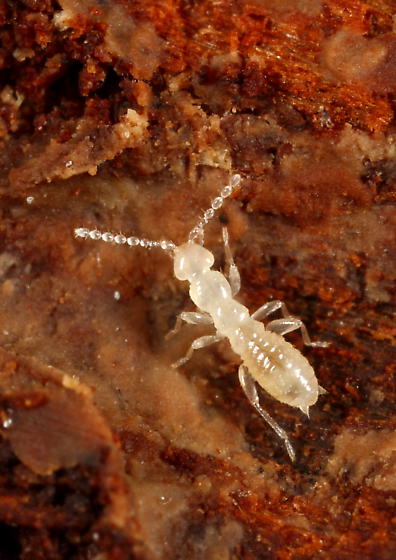Phylum Arthropoda
Subphylum Hexapoda
Class Insecta
Order Zoraptera
Common name: zorapterans
Overview
Zoraptera are small, elongate insects, usually about 3 mm long. Superficially they resemble termites (Isoptera) or booklice (Psocoptera) in appearance. Two morphs occur in both sexes: winged forms with small eyes that disperse and can shed their wings at basal fractures, leaving small stubs, and blind and wingless (apterous) individuals that live in colonies. Zorapterans have chewing (mandibulate) mouthparts, medium-length segmented antennae, enlarged hind femora with rows of distinctive spines along the lower surfaces, and two short cerci at the end of the abdomen; the cerci are often unequal in size and shape in males, with a distinctive �mating hook�. Zoraptera are generally off-white to brown in colour.
Distribution and diversity
Zorapterans are found predominantly in tropical regions. They are one of the smallest and rarest orders of insects with only about 30 species described from two genera in a single family. Many species of Zoraptera are known from very few individuals and by only one sex. Zoraptera have not been recorded on the Australian mainland but a single species occurs on Christmas Island.
Life cycle
Sperm transfer is direct and eggs are simple and ovoid. Most of the time eggs hatch into nymphs that develop into blind, apterous adults that, typically, dominate the colony. But when conditions are suitable for dispersal, leading to founding of new colonies, nymphs are produced with wing buds and these nymphs develop into winged, eyed adults.
Feeding
Zorapterans mostly feed on fungal hyphae and spores under rotting wood and in leaf litter, but have also been recorded as general scavengers or predators of nematodes, mites and other minute arthropods.
Ecology
Little is known about the biology or feeding habits of the majority of species, and most information is derived from studies on the widespread North American species Zorotypus hubbardi. Zorapterans are gregarious, living in small colonies of 15�120 individuals. Typically, they are found in crevices or under dead bark of moist, decaying logs or in leaf litter. They have also been recorded from termite nests and man-made piles of decaying sawdust.

Zorapteran from Texas, USA.
Image credit: � Graham Montgomery
used with permission

Zorapteran from Texas, USA.
Image credit: � Graham Montgomery
used with permission








